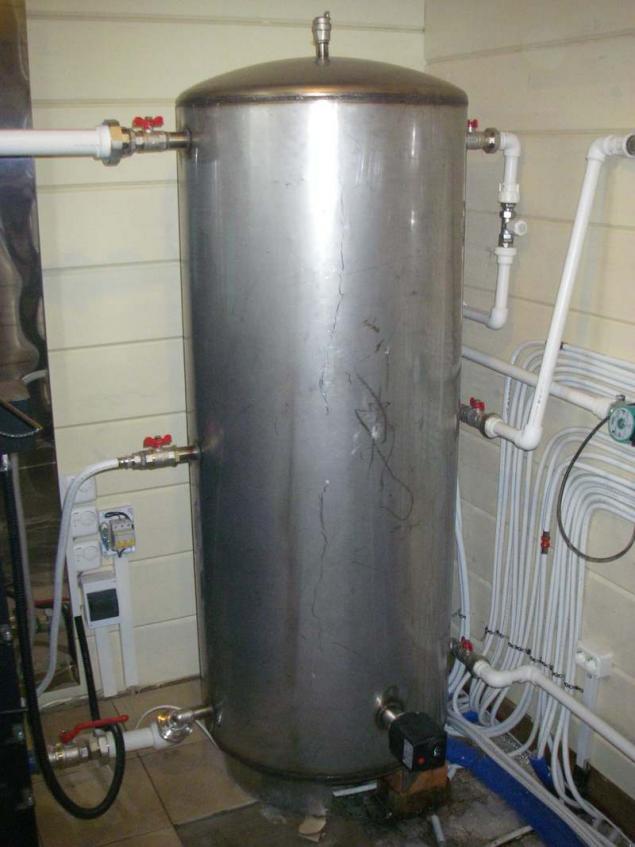1416
What is the energy storage with energy-intensive
There is the question: "Which method of energy storage is preferred in a given situation?". For example, what method of energy storage to choose for a private house or garden, equipped with solar or wind installation? It is clear that large pumped storage station in this case to build, no one will, however, install a large container, raising it to a height of 10 meters, perhaps. But whether this setting is sufficient to maintain a constant supply in the absence of the sun?
To answer your questions, it is necessary to develop some criteria for the evaluation of batteries, allowing to receive an objective assessment. And for that you need to consider the various storage options, allowing to obtain a numerical evaluation.
The capacitance or the stored charge?When talking or writing about car batteries, they often mention the value, which is called the capacity of the battery expressed in ampere-hours (for small batteries in milliamp-hours). But, strictly speaking, Ah is not a unit of capacity. The capacity of the theory of electricity is measured in farads. But ampere-hour is a unit of measurement of charge! That is a characteristic of a battery should be considered (and called) the stored charge.
In physics, charge is measured in coulombs. Coulomb is the amount of charge passing through a conductor when a current of 1 ampere in one second. Since 1 C/c is equal to 1 And, then, moving the clock to seconds, we find that one ampere-hour is equal to 3600 Coulomb.You should note that even the definition of pendant is seen that the charge describes a process, namely the process of passing current through a conductor. The same follows even from the name of another value: one ampere-hour is when a current of one ampere flows through a conductor within the hour.
At first glance it may seem that there's some discrepancy. After all, if we're talking about saving energy, it is stored in either battery energy shall be measured in joules, because a Joule in physics is a unit of energy. But let us remember that the current in the conductor occurs only when there is a potential difference at the ends of the conductor, i.e. the conductor applied voltage. If the voltage at the battery terminals is 1 volt and the conductor flows a charge of one ampere-hour, we get that the battery gave 1 A · 1 A·h = 1 WH of energy.
Thus, with respect to the battery, to speak about stored energy (stored energy) or accumulated (stored) charge. However, since the term "battery capacity" is widespread and somehow more familiar, we are going to use it, but with some refinement, namely, we will talk about the energy capacity.
The size of the energy — energy donated a fully charged battery when discharged to the lowest allowable value.Using this concept, let's try to roughly calculate and compare the energy capacity of different types of energy storage.
The energy capacity of the chemical accumulationist charged electric battery with a stated capacity (charge) at 1 A·h is theoretically able to provide a current of 1 ampere for one hour (or, for example, 10 A during 0.1 hour, or 0.1 amps for 10 hours). But too high current discharge of the battery results in less effective impact of electricity, which reduces the nonlinear time of his employment with such current and may cause overheating. In practice, the battery capacity of the lead, based on a 20 hour discharge cycle to the end voltage.

For automotive batteries, it is 10.8 V. for Example, the inscription on the label "battery 55 Ah" means that he is able to deliver a current of 2.75 amps for 20 hours, and thus the terminal voltage falls below 10.8 V.
Manufacturers of batteries are often specified in technical characteristics of its products the stored energy in watt·hour (Wh), not stored charge in mAh (mAh), which, generally speaking, is not correct. To calculate the stored energy in the stored charge in the General case is not easy: it requires integrating the instantaneous power delivered by the battery during discharge. If greater accuracy is not needed, instead of integration are the average values of voltage and current and use the formula:
1 W·h = 1 A · 1 A·h.
That is stored energy (in WH) is approximately equal to the product of the stored charge (in Ah) by the average voltage (in Volts): E = q · U. for Example, if you specify that the capacity (in the usual sense) 12-volt battery is 60 Ah, stored energy, that is, its energy capacity will be 720 watts · hours.
The energy storage capacity of the gravitational energyIn any physics textbook you can read that A committed to some force F at the rising of a body of mass m to a height h is calculated by the formula A = m · g · h, where g is the acceleration of free fall. This formula occurs in the case where the body motion is slow and the friction forces can be neglected. Work against gravity does not depend on how we raise the body vertically (like a weight in hours) on an inclined plane (as in vtaskivaniya sled uphill) or even in any way.
In all cases, A = m · g · h. When lowering the body to the initial level, the force of gravity will produce the same work which was spent by the force F to lift the body. So, raising body, we have garnered a job, equal to m · g · h, i.e. raised body has the energy equal to the product of gravity acting on the body, and the height at which it is raised. This energy does not depend on which way was up, and is determined only by the position of the body (height at which it is raised or height difference between the initial and final position of the body) and is called the potential energy.

Rate under this formula, the energy capacity of the mass of water pumped into a tank capacity of 1000 liters, is raised 10 meters above ground level (or the level of the turbine hydrogenerator). We assume that the tank has the shape of a cube with an edge length of 1 m. Then, according to the formula in the book by Landsberg, A = 1000 kg · (9.8 m/S2) · 10.5 m = 102900 kg · m2/S2. But 1 kg · m2/S2 1 Joule is equal, and converting into watt-hours, get a total 28,583 watt-hours. That is, to obtain an energy capacity equal to the capacity of conventional electroaccumulators 720 watt-hours, you need to increase the amount of water in the tank at 25.2 times.
The tank will have to have a edge length of about 3 meters. Moreover, its energy capacity is equal to 845 watt-hours. It is more capacity of a single battery, but the installation size is significantly larger than the size of conventional lead-zinc car battery. This comparison suggests that it makes sense to consider not the stored energy in a system energy itself, and in relation to the mass or volume of the system.
The specific energy capacityso we came to the conclusion that the energy capacity, it is expedient to correlate with the mass or volume of the drive itself, or the media, for example, water poured into the tank. We can consider two indicators of this kind.
Mass energy density will be called the energy storage capacity, referred to the weight of the drive.
The volumetric energy density will be called the energy storage capacity, divided by the volume of the drive.
Example. Lead acid battery Panasonic LC-X1265P designed for 12 volts, has an electric charge of 65 ampere-hours and a weight of 20 kg and dimensions (LxWxH) 350 · 166 · 175 mm. of its Life at t = 20 C — 10 years. Thus its mass, the specific energy will be 65 · 12 / 20 = 39 watt-hours per kilogram and volumetric energy intensity— 65 · 12 / (3,5 · 1,66 · 1,75) = 76,7 watt-hours per cubic decimeter or 0,0767 kW-hours per cubic meter.

For the considered in the previous section of the drive of the gravitational energy on the basis of tank water volume of 1000 liters, the specific mass energy consumption will be only 28,583 watt-hours/1,000 kg = 0, 0286 W-HR/kg., in 1363 times less than the mass energy of a lead-zinc battery. Although the service life of the gravity drive may be substantially greater still, from a practical point of view, the tank seems less attractive than the battery.Let's consider a few examples of energy storage and assess their specific energy consumption.
Energy storage tankheat Capacity — the quantity of heat absorbed by the body when it is heated at 1 °C. depending on which quantitative unit is the heat capacity, distinguish mass, volume and molar heat capacity.
Mass specific heat capacity, also known simply as specific heat capacity is the amount of heat which must be supplied to unit mass of a substance to warm it up temperature. In SI is Joule divided by kilogram per Kelvin (j·kg−1·K−1).
Volumetric heat capacity is the amount of heat which must be supplied to unit volume of a substance to warm it up temperature. In SI is measured in joules per cubic meter per Kelvin (j·m−3·K−1).
Molar heat capacity is the amount of heat which must be supplied to 1 pray compounds to heat it temperature. In SI is measured in joules per mole per Kelvin (j/(mol·K)).
Mole — unit of amount of substance in the International system of units. The mole is the amount of substance of a system which contains as many structural elements as there are atoms in carbon-12 is 0.012 kg. the value of specific heat affects the temperature and other thermodynamic parameters. For example, the measurement of specific heat capacity of water will give different results at 20 °C and 60 °C. in addition, the specific heat depends on how it is allowed to change the thermodynamic parameters of a substance (pressure, volume, etc.); for example, the specific heat at constant pressure (CP) and constant volume (CV), generally speaking, different.
The transition of a substance from one aggregate state to another is accompanied by an abrupt change in specific heat capacity for each substance the temperature point of transformation — temperature melting (transition of a solid body to liquid), boiling point (the transition from liquid to gas) and, accordingly, the temperature of the reverse transformation: frost and condensation.
Specific heat capacity of many substances is given in handbooks are usually for a process at constant pressure. For example, the specific heat of liquid water under normal conditions is 4200 j/(kg·K); ice is 2100 j/(kg·K).
On the basis of the above data, one can try to estimate the heat capacity of water heat storage (abstract). Assume that the mass of water equal to 1000 kg (liters). Heat it to 80 °C and let it gives off heat until it has cooled to 30 °C. If you do not bother by the fact that the heat capacity is different at different temperatures, we can assume that the accumulator will give 4200 * 1000 * 50 J. of heat. That is, the energy capacity of such storage tank is 210 58,333 megajoules or kilowatt-hours of energy.
If we compare this value with the energy charge normal car battery (720 watt-hours), we see that the energy capacity is considered equal to the heat storage energy capacity of approximately 810 electric batteries.
Specific mass energy capacity of such storage tank, (even without taking into account the mass of the vessel, which in fact will be stored the heated water, and masses of insulation) is 58.3 kWh/1000 kg = 58,3 W-HR/kg. It is kinda bigger than the mass energy of a lead-zinc battery, are equal, as was calculated above, 39 WH/kg.
According to rough estimates, the heat storage is comparable with a conventional car battery and volume specific power consumption, since a kilogram of water is a decimeter of volume, hence its volume, the specific energy is also equal to 76.7 WH/kg. that is exactly the same as the volumetric specific heat capacity of lead-acid battery. However, in the calculation of storage tank, we only considered the volume of water, although one would have to consider tank volume and insulation. But in any case, the loss will not be so great as to gravitatsionnogo drive.
Other types of energy storageIn the article "Overview of storage (batteries) energy" calculations of specific energomasha some energy storage. Will draw out some examples
Nakopiteli capacitor a capacitor of 1 f and a voltage of 250 V the stored energy is: E = CU2 /2 = 1 ∙ 2502 /2 = 31.25 kJ ~ 8.69 W · h. If you use electrolytic capacitors, then their weight could be 120 kg. Specific energy storage in this case is 0.26 kJ/kg or 0,072 W/kg. In operation, the drive can within one hour to provide a load of not more than 9 watts. The lifetime of electrolytic capacitors can reach 20 years. Supercapacitors on the density of the stored energy close to the chemical batteries. Advantages: the stored energy can be used for a short period of time.
Gravity drives koprovogo typeInitially raise the body weight of 2000 kg to a height of 5 m. Then the body is lowered under the action of gravity, rotating the generator. E = mgh ~ 2000 ∙ 10 ∙ 5 = 100 kJ ~ 27.8 W · h. Specific energy capacity is 0.0138 W · h/kg. In operation, the drive can in the next hour to ensure the load is not more than 28 watts. The life of the drive can be 20 years or more.
Advantages: the stored energy can be used for a short period of time.
The flywheel isthe Energy stored in the flywheel, can be found by the formula E = 0.5 w2 J , where J is the moment of inertia of a rotating body. For a cylinder of radius R and height H:
J = 0.5 p r R4 H
where r is the density of the material of the cylinder.
Limit linear velocity at the periphery of the flywheel Vmax (approximately 200 m/s for steel).
Vmax = wmax or wmax R = Vmax /R
Then Emax = 0.5 J w2max = 0.25 p r R2 H V2max = 0.25 M V2max
Specific energy is: Emax /M = 0.25 V2max
For steel cylindrical flywheel maximum specific energy is approximately 10 kJ/kg. flywheel mass of 100 kg (R = 0.2 m, H = 0.1 m) the maximum stored energy can be 0.25 ∙ 3.14 ∙ 8000 ∙ 0.22 ∙ 0.1 ∙ 2002 ~ 1 MJ ~ 0.278 kWh. In operation, the drive can in the next hour to ensure the load is not more than 280 watts. The service life of the flywheel can be 20 years or more. Advantages: the stored energy can be used for a short period of time, the characteristics can be significantly improved.
The super flywheel, the super flywheel unlike conventional flywheels are capable of due to design features theoretically store up to 500 W·h / kg. However, the development of super stopped for some reason.
Pneumatic driveIn a steel tank with a capacity of 1 m3 of pumped air under a pressure of 50 atmospheres. To withstand such pressure, the container walls should have a thickness of approximately 5 mm. Compressed air is used to perform work. In an isothermal process is A work made by ideal gas in expanding into the atmosphere is determined by the formula:
A = (M / M ) ∙ R ∙ T ∙ ln (V2 / V1 )
where M is the mass of gas, m — molar mass of gas, R is the universal gas constant, T is the absolute temperature, V1 is the initial volume of gas V2 is the final volume of gas. Taking into account the equation of state for an ideal gas (P1 ∙ V1 = P2 ∙ V2 ) for a given realization of the drive V2 / V1 = 50, R = 8.31 j/(mol · deg), T = 293 0K, M / M ~ 50: 0.0224 ~ 2232, working gas in the expansion 2232 ∙ 8.31 ∙ 293 ∙ ln 50 ~ 20 MJ ~ 5.56 kWh per cycle. The mass storage device is approximately equal to 250 kg. Specific energy is 80 kJ/kg With pneumatic drive can for one hour to ensure the load is not more than 5.5 kW. The service life of the pneumatic drive can be 20 years or more.
Advantages: the accumulator tank can be located underground, as the reservoir can be used with standard gas cylinders in the required quantity with the appropriate equipment, using the latest wind turbine can directly operate the compressor pump, a relatively large number of devices, directly using energy of compressed air.
Comparative table of some energy storageAll the above parameter values of energy storage are summarized in the summary table. But first, note that the specific energy consumption allows you to compare drives with conventional fuels.
The main characteristic of a fuel is its calorific value, ie the amount of heat released by complete combustion. Distinguish between specific heat of combustion (MJ/kg) and volume (MJ/m3). Converting MJ to kilowatt-hours received:
Fuel Energy capacity (kWh /kg) Wood 2,33-4,32 2,33 oil shale – Peat 5,82 2,33 – Of 4.66 Brown coal of 2.92 -5,82 coal Anthracite approx. 8,15 Of 9.08 – 9,32 Oil 11,63 Gasoline 12,8 kWh/kg of 9.08 kWh/liter
As you can see, the specific energy consumption of fuel is much higher than the energy intensity of the energy storage. Because as a backup energy source often used diesel generators, include in the summary table the energy content of diesel fuel, which is equal 42624 kJ/kg or of 11.84 kW-hours/kg. And add to compare more natural gas and hydrogen, since the latter can also serve as a basis for the creation of energy storage.
Specific mass energy bottled gas (propane-butane) is 36 MJ/kg or 10 KWh/kg, and the hydrogen of 33.58 KWh/kg.
The result is the following table with the parameters of the considered energy storage (last two rows in this table can be compared with the traditional energy carriers):
The energy storage Characteristics possible
the implementation of the drive Stored
energy KWh Specific energy capacity,
W · h/kg Maximum working time
for a load of 100 watts, min Volume, the specific energy,
W · h/dm3 service Life,
years Copra copra Weight 2 tons, height
lift 5 m 0,0278 0.0139 16,7 2,78/the volume of copra in DM for more than 20 Hydraulic gravitational Mass of water 1000 kg, the height of the pump 10 m 0,0286 0,0286 0,0286 of 16.7 more than 20 Capacitor Bank with a capacity of 1 f,
voltage 250 V weight 120 kg 0,00868 0.072 5.2 0,0868 to 20 Flywheel Steel flywheel of mass 100 kg and diameter 0.4 m, thickness 0.1 m 0,278 2,78 69,5 166,8 more than 20 Lead-acid battery Capacity 190 a·h, output voltage 12V, weight 70 kg of 15.47 60-75 1,083 650 3 ... 5 Pneumatic Steel tank with a volume of 1 м3массой 250 kg compressed air under a pressure of 50 atmospheres 22,2 3330 0,556 0,556 more than 20 a storage tank Volume of 1000 litres of water heated to 80 °C, Of 58.33 of 58.33 34998 of 58.33 to 20 a Balloon with hydrogen the Volume of 50 l, density 0.09 kg/m3, compression ratio 10:1 (mass 0,045 kg) 1,5 33580 906,66 671600 more than 20 gas Cylinder with propane-butane gas Volume of 50 liters, the density of 0,717 kg/m3, compression ratio 10:1 (weight 0,36 kg) 3,6 2160 10000 200000 more than 20 Canister with diesel fuel Volume of 50 l (=40kg) 473,6 11840 284160 236800 more than 20
In this table the figures are very approximate, the calculations do not take into account a lot of factors, for example, the coefficient of useful action of the generator that uses stored energy, the volume and weight of necessary equipment and so on. However, these figures would, in my opinion, to give an initial assessment of the potential intensity of various types of energy storage.
And, as is shown in the table, the most effective of the drive appear to be a balloon with hydrogen. If hydrogen is used "gratuitous" (excess) energy from renewable sources, the hydrogen storage device may be the most promising.
Hydrogen can be used as fuel in a conventional internal combustion engine, which will rotate the generator, or hydrogen fuel cells that directly produce electricity. The question of which method is more profitable, requires separate consideration. Well, and safety issues in the production and use of hydrogen can make adjustments when considering the appropriateness of a particular type of energy storage. published
P. S. And remember, only by changing their consumption — together we change the world! ©
Join us in Facebook , Vkontakte, Odnoklassniki
Source: altenergiya.ru/accumulator/kakoj-nakopitel-energii-samyj-energoemkij.html
To answer your questions, it is necessary to develop some criteria for the evaluation of batteries, allowing to receive an objective assessment. And for that you need to consider the various storage options, allowing to obtain a numerical evaluation.
The capacitance or the stored charge?When talking or writing about car batteries, they often mention the value, which is called the capacity of the battery expressed in ampere-hours (for small batteries in milliamp-hours). But, strictly speaking, Ah is not a unit of capacity. The capacity of the theory of electricity is measured in farads. But ampere-hour is a unit of measurement of charge! That is a characteristic of a battery should be considered (and called) the stored charge.
In physics, charge is measured in coulombs. Coulomb is the amount of charge passing through a conductor when a current of 1 ampere in one second. Since 1 C/c is equal to 1 And, then, moving the clock to seconds, we find that one ampere-hour is equal to 3600 Coulomb.You should note that even the definition of pendant is seen that the charge describes a process, namely the process of passing current through a conductor. The same follows even from the name of another value: one ampere-hour is when a current of one ampere flows through a conductor within the hour.
At first glance it may seem that there's some discrepancy. After all, if we're talking about saving energy, it is stored in either battery energy shall be measured in joules, because a Joule in physics is a unit of energy. But let us remember that the current in the conductor occurs only when there is a potential difference at the ends of the conductor, i.e. the conductor applied voltage. If the voltage at the battery terminals is 1 volt and the conductor flows a charge of one ampere-hour, we get that the battery gave 1 A · 1 A·h = 1 WH of energy.
Thus, with respect to the battery, to speak about stored energy (stored energy) or accumulated (stored) charge. However, since the term "battery capacity" is widespread and somehow more familiar, we are going to use it, but with some refinement, namely, we will talk about the energy capacity.
The size of the energy — energy donated a fully charged battery when discharged to the lowest allowable value.Using this concept, let's try to roughly calculate and compare the energy capacity of different types of energy storage.
The energy capacity of the chemical accumulationist charged electric battery with a stated capacity (charge) at 1 A·h is theoretically able to provide a current of 1 ampere for one hour (or, for example, 10 A during 0.1 hour, or 0.1 amps for 10 hours). But too high current discharge of the battery results in less effective impact of electricity, which reduces the nonlinear time of his employment with such current and may cause overheating. In practice, the battery capacity of the lead, based on a 20 hour discharge cycle to the end voltage.

For automotive batteries, it is 10.8 V. for Example, the inscription on the label "battery 55 Ah" means that he is able to deliver a current of 2.75 amps for 20 hours, and thus the terminal voltage falls below 10.8 V.
Manufacturers of batteries are often specified in technical characteristics of its products the stored energy in watt·hour (Wh), not stored charge in mAh (mAh), which, generally speaking, is not correct. To calculate the stored energy in the stored charge in the General case is not easy: it requires integrating the instantaneous power delivered by the battery during discharge. If greater accuracy is not needed, instead of integration are the average values of voltage and current and use the formula:
1 W·h = 1 A · 1 A·h.
That is stored energy (in WH) is approximately equal to the product of the stored charge (in Ah) by the average voltage (in Volts): E = q · U. for Example, if you specify that the capacity (in the usual sense) 12-volt battery is 60 Ah, stored energy, that is, its energy capacity will be 720 watts · hours.
The energy storage capacity of the gravitational energyIn any physics textbook you can read that A committed to some force F at the rising of a body of mass m to a height h is calculated by the formula A = m · g · h, where g is the acceleration of free fall. This formula occurs in the case where the body motion is slow and the friction forces can be neglected. Work against gravity does not depend on how we raise the body vertically (like a weight in hours) on an inclined plane (as in vtaskivaniya sled uphill) or even in any way.
In all cases, A = m · g · h. When lowering the body to the initial level, the force of gravity will produce the same work which was spent by the force F to lift the body. So, raising body, we have garnered a job, equal to m · g · h, i.e. raised body has the energy equal to the product of gravity acting on the body, and the height at which it is raised. This energy does not depend on which way was up, and is determined only by the position of the body (height at which it is raised or height difference between the initial and final position of the body) and is called the potential energy.

Rate under this formula, the energy capacity of the mass of water pumped into a tank capacity of 1000 liters, is raised 10 meters above ground level (or the level of the turbine hydrogenerator). We assume that the tank has the shape of a cube with an edge length of 1 m. Then, according to the formula in the book by Landsberg, A = 1000 kg · (9.8 m/S2) · 10.5 m = 102900 kg · m2/S2. But 1 kg · m2/S2 1 Joule is equal, and converting into watt-hours, get a total 28,583 watt-hours. That is, to obtain an energy capacity equal to the capacity of conventional electroaccumulators 720 watt-hours, you need to increase the amount of water in the tank at 25.2 times.
The tank will have to have a edge length of about 3 meters. Moreover, its energy capacity is equal to 845 watt-hours. It is more capacity of a single battery, but the installation size is significantly larger than the size of conventional lead-zinc car battery. This comparison suggests that it makes sense to consider not the stored energy in a system energy itself, and in relation to the mass or volume of the system.
The specific energy capacityso we came to the conclusion that the energy capacity, it is expedient to correlate with the mass or volume of the drive itself, or the media, for example, water poured into the tank. We can consider two indicators of this kind.
Mass energy density will be called the energy storage capacity, referred to the weight of the drive.
The volumetric energy density will be called the energy storage capacity, divided by the volume of the drive.
Example. Lead acid battery Panasonic LC-X1265P designed for 12 volts, has an electric charge of 65 ampere-hours and a weight of 20 kg and dimensions (LxWxH) 350 · 166 · 175 mm. of its Life at t = 20 C — 10 years. Thus its mass, the specific energy will be 65 · 12 / 20 = 39 watt-hours per kilogram and volumetric energy intensity— 65 · 12 / (3,5 · 1,66 · 1,75) = 76,7 watt-hours per cubic decimeter or 0,0767 kW-hours per cubic meter.

For the considered in the previous section of the drive of the gravitational energy on the basis of tank water volume of 1000 liters, the specific mass energy consumption will be only 28,583 watt-hours/1,000 kg = 0, 0286 W-HR/kg., in 1363 times less than the mass energy of a lead-zinc battery. Although the service life of the gravity drive may be substantially greater still, from a practical point of view, the tank seems less attractive than the battery.Let's consider a few examples of energy storage and assess their specific energy consumption.
Energy storage tankheat Capacity — the quantity of heat absorbed by the body when it is heated at 1 °C. depending on which quantitative unit is the heat capacity, distinguish mass, volume and molar heat capacity.
Mass specific heat capacity, also known simply as specific heat capacity is the amount of heat which must be supplied to unit mass of a substance to warm it up temperature. In SI is Joule divided by kilogram per Kelvin (j·kg−1·K−1).
Volumetric heat capacity is the amount of heat which must be supplied to unit volume of a substance to warm it up temperature. In SI is measured in joules per cubic meter per Kelvin (j·m−3·K−1).
Molar heat capacity is the amount of heat which must be supplied to 1 pray compounds to heat it temperature. In SI is measured in joules per mole per Kelvin (j/(mol·K)).
Mole — unit of amount of substance in the International system of units. The mole is the amount of substance of a system which contains as many structural elements as there are atoms in carbon-12 is 0.012 kg. the value of specific heat affects the temperature and other thermodynamic parameters. For example, the measurement of specific heat capacity of water will give different results at 20 °C and 60 °C. in addition, the specific heat depends on how it is allowed to change the thermodynamic parameters of a substance (pressure, volume, etc.); for example, the specific heat at constant pressure (CP) and constant volume (CV), generally speaking, different.
The transition of a substance from one aggregate state to another is accompanied by an abrupt change in specific heat capacity for each substance the temperature point of transformation — temperature melting (transition of a solid body to liquid), boiling point (the transition from liquid to gas) and, accordingly, the temperature of the reverse transformation: frost and condensation.
Specific heat capacity of many substances is given in handbooks are usually for a process at constant pressure. For example, the specific heat of liquid water under normal conditions is 4200 j/(kg·K); ice is 2100 j/(kg·K).
On the basis of the above data, one can try to estimate the heat capacity of water heat storage (abstract). Assume that the mass of water equal to 1000 kg (liters). Heat it to 80 °C and let it gives off heat until it has cooled to 30 °C. If you do not bother by the fact that the heat capacity is different at different temperatures, we can assume that the accumulator will give 4200 * 1000 * 50 J. of heat. That is, the energy capacity of such storage tank is 210 58,333 megajoules or kilowatt-hours of energy.
If we compare this value with the energy charge normal car battery (720 watt-hours), we see that the energy capacity is considered equal to the heat storage energy capacity of approximately 810 electric batteries.
Specific mass energy capacity of such storage tank, (even without taking into account the mass of the vessel, which in fact will be stored the heated water, and masses of insulation) is 58.3 kWh/1000 kg = 58,3 W-HR/kg. It is kinda bigger than the mass energy of a lead-zinc battery, are equal, as was calculated above, 39 WH/kg.
According to rough estimates, the heat storage is comparable with a conventional car battery and volume specific power consumption, since a kilogram of water is a decimeter of volume, hence its volume, the specific energy is also equal to 76.7 WH/kg. that is exactly the same as the volumetric specific heat capacity of lead-acid battery. However, in the calculation of storage tank, we only considered the volume of water, although one would have to consider tank volume and insulation. But in any case, the loss will not be so great as to gravitatsionnogo drive.
Other types of energy storageIn the article "Overview of storage (batteries) energy" calculations of specific energomasha some energy storage. Will draw out some examples
Nakopiteli capacitor a capacitor of 1 f and a voltage of 250 V the stored energy is: E = CU2 /2 = 1 ∙ 2502 /2 = 31.25 kJ ~ 8.69 W · h. If you use electrolytic capacitors, then their weight could be 120 kg. Specific energy storage in this case is 0.26 kJ/kg or 0,072 W/kg. In operation, the drive can within one hour to provide a load of not more than 9 watts. The lifetime of electrolytic capacitors can reach 20 years. Supercapacitors on the density of the stored energy close to the chemical batteries. Advantages: the stored energy can be used for a short period of time.
Gravity drives koprovogo typeInitially raise the body weight of 2000 kg to a height of 5 m. Then the body is lowered under the action of gravity, rotating the generator. E = mgh ~ 2000 ∙ 10 ∙ 5 = 100 kJ ~ 27.8 W · h. Specific energy capacity is 0.0138 W · h/kg. In operation, the drive can in the next hour to ensure the load is not more than 28 watts. The life of the drive can be 20 years or more.
Advantages: the stored energy can be used for a short period of time.
The flywheel isthe Energy stored in the flywheel, can be found by the formula E = 0.5 w2 J , where J is the moment of inertia of a rotating body. For a cylinder of radius R and height H:
J = 0.5 p r R4 H
where r is the density of the material of the cylinder.
Limit linear velocity at the periphery of the flywheel Vmax (approximately 200 m/s for steel).
Vmax = wmax or wmax R = Vmax /R
Then Emax = 0.5 J w2max = 0.25 p r R2 H V2max = 0.25 M V2max
Specific energy is: Emax /M = 0.25 V2max
For steel cylindrical flywheel maximum specific energy is approximately 10 kJ/kg. flywheel mass of 100 kg (R = 0.2 m, H = 0.1 m) the maximum stored energy can be 0.25 ∙ 3.14 ∙ 8000 ∙ 0.22 ∙ 0.1 ∙ 2002 ~ 1 MJ ~ 0.278 kWh. In operation, the drive can in the next hour to ensure the load is not more than 280 watts. The service life of the flywheel can be 20 years or more. Advantages: the stored energy can be used for a short period of time, the characteristics can be significantly improved.
The super flywheel, the super flywheel unlike conventional flywheels are capable of due to design features theoretically store up to 500 W·h / kg. However, the development of super stopped for some reason.
Pneumatic driveIn a steel tank with a capacity of 1 m3 of pumped air under a pressure of 50 atmospheres. To withstand such pressure, the container walls should have a thickness of approximately 5 mm. Compressed air is used to perform work. In an isothermal process is A work made by ideal gas in expanding into the atmosphere is determined by the formula:
A = (M / M ) ∙ R ∙ T ∙ ln (V2 / V1 )
where M is the mass of gas, m — molar mass of gas, R is the universal gas constant, T is the absolute temperature, V1 is the initial volume of gas V2 is the final volume of gas. Taking into account the equation of state for an ideal gas (P1 ∙ V1 = P2 ∙ V2 ) for a given realization of the drive V2 / V1 = 50, R = 8.31 j/(mol · deg), T = 293 0K, M / M ~ 50: 0.0224 ~ 2232, working gas in the expansion 2232 ∙ 8.31 ∙ 293 ∙ ln 50 ~ 20 MJ ~ 5.56 kWh per cycle. The mass storage device is approximately equal to 250 kg. Specific energy is 80 kJ/kg With pneumatic drive can for one hour to ensure the load is not more than 5.5 kW. The service life of the pneumatic drive can be 20 years or more.
Advantages: the accumulator tank can be located underground, as the reservoir can be used with standard gas cylinders in the required quantity with the appropriate equipment, using the latest wind turbine can directly operate the compressor pump, a relatively large number of devices, directly using energy of compressed air.
Comparative table of some energy storageAll the above parameter values of energy storage are summarized in the summary table. But first, note that the specific energy consumption allows you to compare drives with conventional fuels.
The main characteristic of a fuel is its calorific value, ie the amount of heat released by complete combustion. Distinguish between specific heat of combustion (MJ/kg) and volume (MJ/m3). Converting MJ to kilowatt-hours received:
Fuel Energy capacity (kWh /kg) Wood 2,33-4,32 2,33 oil shale – Peat 5,82 2,33 – Of 4.66 Brown coal of 2.92 -5,82 coal Anthracite approx. 8,15 Of 9.08 – 9,32 Oil 11,63 Gasoline 12,8 kWh/kg of 9.08 kWh/liter
As you can see, the specific energy consumption of fuel is much higher than the energy intensity of the energy storage. Because as a backup energy source often used diesel generators, include in the summary table the energy content of diesel fuel, which is equal 42624 kJ/kg or of 11.84 kW-hours/kg. And add to compare more natural gas and hydrogen, since the latter can also serve as a basis for the creation of energy storage.
Specific mass energy bottled gas (propane-butane) is 36 MJ/kg or 10 KWh/kg, and the hydrogen of 33.58 KWh/kg.
The result is the following table with the parameters of the considered energy storage (last two rows in this table can be compared with the traditional energy carriers):
The energy storage Characteristics possible
the implementation of the drive Stored
energy KWh Specific energy capacity,
W · h/kg Maximum working time
for a load of 100 watts, min Volume, the specific energy,
W · h/dm3 service Life,
years Copra copra Weight 2 tons, height
lift 5 m 0,0278 0.0139 16,7 2,78/the volume of copra in DM for more than 20 Hydraulic gravitational Mass of water 1000 kg, the height of the pump 10 m 0,0286 0,0286 0,0286 of 16.7 more than 20 Capacitor Bank with a capacity of 1 f,
voltage 250 V weight 120 kg 0,00868 0.072 5.2 0,0868 to 20 Flywheel Steel flywheel of mass 100 kg and diameter 0.4 m, thickness 0.1 m 0,278 2,78 69,5 166,8 more than 20 Lead-acid battery Capacity 190 a·h, output voltage 12V, weight 70 kg of 15.47 60-75 1,083 650 3 ... 5 Pneumatic Steel tank with a volume of 1 м3массой 250 kg compressed air under a pressure of 50 atmospheres 22,2 3330 0,556 0,556 more than 20 a storage tank Volume of 1000 litres of water heated to 80 °C, Of 58.33 of 58.33 34998 of 58.33 to 20 a Balloon with hydrogen the Volume of 50 l, density 0.09 kg/m3, compression ratio 10:1 (mass 0,045 kg) 1,5 33580 906,66 671600 more than 20 gas Cylinder with propane-butane gas Volume of 50 liters, the density of 0,717 kg/m3, compression ratio 10:1 (weight 0,36 kg) 3,6 2160 10000 200000 more than 20 Canister with diesel fuel Volume of 50 l (=40kg) 473,6 11840 284160 236800 more than 20
In this table the figures are very approximate, the calculations do not take into account a lot of factors, for example, the coefficient of useful action of the generator that uses stored energy, the volume and weight of necessary equipment and so on. However, these figures would, in my opinion, to give an initial assessment of the potential intensity of various types of energy storage.
And, as is shown in the table, the most effective of the drive appear to be a balloon with hydrogen. If hydrogen is used "gratuitous" (excess) energy from renewable sources, the hydrogen storage device may be the most promising.
Hydrogen can be used as fuel in a conventional internal combustion engine, which will rotate the generator, or hydrogen fuel cells that directly produce electricity. The question of which method is more profitable, requires separate consideration. Well, and safety issues in the production and use of hydrogen can make adjustments when considering the appropriateness of a particular type of energy storage. published
P. S. And remember, only by changing their consumption — together we change the world! ©
Join us in Facebook , Vkontakte, Odnoklassniki
Source: altenergiya.ru/accumulator/kakoj-nakopitel-energii-samyj-energoemkij.html























